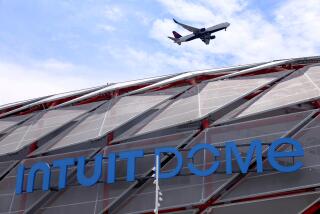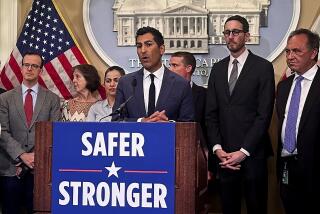Assembly OKs Bill Cutting Legal Standard for Drunk Driving to .08%
SACRAMENTO — Urged to send a strong message to drunk drivers, the Assembly on Thursday passed legislation to lower the legal blood-alcohol level from .10% to .08%, giving California one of the toughest anti-drunk-driving laws in the country.
The bill was approved on an overwhelming 65-5 vote and returned to the Senate for action on minor Assembly amendments.
Sen. Bill Leonard (R-Big Bear), the bill’s author, said he expects the Senate to approve the measure in its final form and send it to Gov. George Deukmejian. A spokesman for the governor said Deukmejian has no position on the specific bill but supports the “general concept” of lowering the legal limit to .08%.
Under the measure, a jury would be required to find a defendant guilty of drunk driving whenever it is proved that the driver’s blood-alcohol level was at least .08%. The proposal would also require the Department of Motor Vehicles to revoke or suspend the license of any motorist found to have caused an accident while drunk within five years after being convicted on drinking-related vehicular manslaughter charges.
Assemblyman Richard Katz (D-Sylmar), who carried the bill on the Assembly floor, said there were more than 2,500 alcohol-related accident deaths in California in 1987. In at least 25% of those cases, he added, the drunk driver had a blood alcohol level below the current legal limit of .10%.
“Everyone who drives on the road has the right to be safe,” Katz said. “Everyone who walks across the street has a right to be safe. They have a right not to be under attack by drunk drivers. This bill will help those people be safe on the roads.”
Assemblyman Stan Statham (R-Oak Run) said the limit now is far too lenient.
“When you’re at .10, you are a staggering drunk,” he said. “If you’re not a staggering drunk, that means you are a professional drunk. This is an outstanding measure that will do a lot to alleviate the drunk-driving problem.”
But the few members who opposed the bill argued that the measure would have little impact on the incidence of drunk driving. Instead, they said, it would only make it easier to convict and fine people who have been drinking but whose driving skills are not necessarily impaired.
“This is a measure to raise more money, pure and simple,” said Richard E. Floyd (D-Carson). “We need to have the cops out there picking up the real drunk drivers, not sitting outside the bars waiting for someone to leave.”
Added Assemblyman Frank Hill (R-Whittier): “This bill is not about impairment. This bill is about eliminating any alcohol in your system when you drive.”
No Single Rule
Leonard, a nondrinker, said there is no single rule on how many drinks different sized people can consume before their blood alcohol concentration reaches .08%. Various studies have concluded that anywhere from three to seven drinks in an hour could do it.
But he added that the effect of his bill on public awareness about the perils of drinking and then driving would be almost as important as the impact of the technical change in the law. He said the state of Maine experienced a 30% drop in alcohol-related accidents after the state cut its legal limit to .08%.
“If I didn’t do this bill, I would find another that would deal with drunk driving in order to send a message to the public not to be complacent about a very significant problem,” Leonard said.
More to Read
Get the L.A. Times Politics newsletter
Deeply reported insights into legislation, politics and policy from Sacramento, Washington and beyond. In your inbox three times per week.
You may occasionally receive promotional content from the Los Angeles Times.










